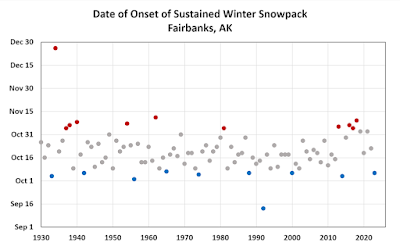Objective Comments and Analysis - All Science, No Politics
Primary Author Richard James
2010-2013 Author Rick Thoman
Friday, October 27, 2023
Radar Trends
Saturday, October 21, 2023
Kaktovik Wind
Blizzard season is off to an early start in Alaska's capital for that kind of thing: Kaktovik, on Alaska's eastern Arctic coast. Snow has been flying since Thursday morning, and winds increased to 50 mph yesterday evening (with gusts to 60 mph). Thanks to reader Mike for bringing this to my attention.
October is rather early for this kind of weather in Kaktovik, and it's been more than 10 years since such high winds were observed in October. In winter proper it's more common, with more than 5% of days seeing sustained winds over 45 mph in November through February.
Here's the meteorological setup: high pressure over western and central Alaska, and a deep low pressure system over Banks Island (as of 4pm AKST yesterday). My clumsy annotation shows the direction of the strong pressure gradient, and Barter Island's location is indicated with the red dot: click to enlarge.
Thursday, October 19, 2023
Statewide Temperature Index
Last week I mentioned the UAF/ACCAP statewide temperature index (developed by Rick Thoman and Brian Brettschneider), which is a useful tool for quickly visualizing the overall ebb and flow of temperature anomalies in Alaska. Here's the last year or so (click to enlarge):
Two of the more striking anomalies in recent months were the extraordinary warmth of late summer and the April cold spell.
While I'm a big fan of the index that Rick and Brian came up with, I've been tinkering to see if it can be improved still further. One of the limitations of the existing index is that it assumes a Normal distribution for daily mean temperatures, but we know that the distribution is significantly skewed at certain locations and times of year. Here's an old post illustrating this:
https://ak-wx.blogspot.com/2014/03/temperature-skewness-maps.html
To account for skewness, I was able to fit a Skew-Normal distribution to the historical temperatures at each of the 25 ASOS locations used in the ACCAP index. Using these distributions - which vary through the year - the statewide index can then be recalculated from the newly standardized anomalies at the individual locations.
This modification makes a fairly big difference at certain times of the year. An extreme example is late March 2019, when extremely warm weather occurred at a time of year when skewness is negative for most of the state. In other words, negative departures from normal tend to be larger than positive departures, and so a large warm anomaly is actually much more unusual than a Normal distribution would imply. Here's an illustration of the standardized anomalies on March 22 that year, using a Normal distribution (top) and a Skew-Normal distribution (bottom):
The standardized anomalies are much larger in the Skew-Normal framework, and the statewide anomaly jumps from +2.15 to +2.71. In terms of degree-of-rarity, the Normal distribution estimates a 98.4% percentile for the day, but the Skew-Normal distribution shows 99.7%. Both are in the upper tail, but accounting for the negative skewness reveals that the warmth was statistically much more extreme.
It works the other way too: a few months later in 2019, extreme heat occurred in early July, but with positive skewness around Alaska's coastal regions, the large warm anomalies were somewhat less significant than a Normal distribution would indicate. The statewide standardized anomaly drops from +3.16 to +2.88, which although not a large change implies more than a 50% increase in the climatological probability of such an event (0.08% vs 0.20%).
Friday, October 13, 2023
Early Snowpack
Thursday, October 5, 2023
Signs of Freeze-Up
Tuesday, October 3, 2023
First Snow in Fairbanks
The first accumulating snow fell in Fairbanks today - right on time according to the calendar. The median date since 1930 is October 2nd. But these were also the first flakes to be reported in the air at the airport, and that typically happens a few days earlier: September 26 on average.
Its getting white outside our office this morning. ❄️A weather front moving east across the Interior will bring areas of light snow ranging from one half to 2 inches before the snow ends tonight. How much snow have you seen so far? Have a nice day out there. #akwx pic.twitter.com/3AezK9w2JX
— NWS Fairbanks (@NWSFairbanks) October 3, 2023
This morning's Fairbanks sounding showed a temperature profile entirely below freezing, and it's also the first time that has happened so far this season. This is also close to normal. The odds of any particular 3am sounding being entirely below freezing in Fairbanks rises approximately as follows:
10% September 20
25% October 1
50% October 10
75% October 27
85-90% November 15
It's more uncommon to see a sub-freezing profile in the 3pm sounding at the beginning of October, because there's still a modicum of solar heating to produce a modest diurnal temperature cycle. Today's 3pm sounding reported exactly 0°C a small distance above the ground. But the historical frequency of a fully sub-freezing afternoon profile rises quickly as that solar heating gets snuffed out:
10% October 3
25% October 9
50% October 18
75% November 1
85-90% November 15
Appealing views from the Nenana webcam today:























